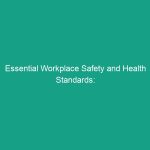Good Morning Team!
Today, we’re diving into a crucial topic that impacts our Safety on the job site: Essential Guidelines for Crane Proximity to Power Lines: Maintaining Safe Distances. Understanding how to operate cranes safely near power lines is not just about following Regulations; it’s about protecting ourselves and our coworkers from potential Hazards. Let’s explore why this is vital for our daily operations and how we can ensure a safe working Environment.
Understanding Crane Proximity to Power Lines
When we talk about crane proximity to power lines, we refer to the safe distances that must be maintained while operating cranes near overhead electrical lines. These guidelines are essential for preventing accidents that could lead to serious injuries or even fatalities. Many employees may think that if they are careful, they can operate close to power lines without incident. However, the reality is that even a small miscalculation can have devastating consequences.
Key Hazards, Risks, and Safety Considerations
Operating cranes near power lines poses several hazards:
- Electrocution: Contact with power lines can result in severe injuries or fatalities due to electric shock.
- Equipment Damage: Cranes can be damaged if they come into contact with power lines, leading to costly repairs and downtime.
- Project Delays: Accidents can halt work, leading to delays and loss of productivity.
Ignoring these safety protocols can lead to real-world consequences. For instance, a crane operator who misjudges the distance to a power line can cause a power outage or even ignite a fire, leading to significant damages and legal repercussions.
Best Practices, Procedures, & Actionable Advice
To maintain safe distances from power lines, follow these essential guidelines:
- Know Your Surroundings: Before starting work, assess the site for the location of overhead power lines. Use a site map if available.
- Establish a Safety Zone: Maintain a minimum distance of 10 feet from power lines for voltages up to 50 kV. For higher voltages, increase the distance accordingly.
- Use Spotters: Assign a qualified spotter to help guide the crane operator and ensure safe distances are maintained.
- Use Insulated Equipment: If operations near power lines are unavoidable, use insulated cranes and tools to reduce the risk of electrocution.
- Stay Informed: Regularly participate in safety Training and refreshers on crane Operation and Electrical Hazards.
For instance, there was a case where a crane operator failed to maintain the proper distance from a power line, resulting in a power outage and severe injury to the operator. This incident serves as a reminder of the importance of adhering to Safety Guidelines.
Regulations, Standards, and Compliance
Understanding the regulations set forth by organizations like OSHA is crucial for compliance and safety. osha outlines specific guidelines for crane operations near power lines, emphasizing the importance of maintaining safe distances. Compliance with these regulations not only protects employees but also ensures that the company meets legal safety Standards, preventing potential fines and liabilities.
Employee Engagement & Discussion
Now that we’ve covered the essential guidelines for maintaining safe distances from power lines, let’s open the floor for discussion. What safety challenges have you encountered related to operating cranes near power lines? Are there any experiences you’d like to share that could help us all learn? Your insights are invaluable in promoting a culture of safety.
Conclusion & Key Takeaways
In conclusion, staying aware of crane proximity to power lines is crucial for maintaining a safe work environment. Remember to:
- Assess your surroundings and establish a safety zone.
- Use spotters and insulated equipment when necessary.
- Stay informed about safety regulations and Best Practices.
By adhering to these guidelines, we can significantly reduce the risks associated with crane operations near power lines. Let’s prioritize safety and look out for one another. Thank you all for your attention and commitment to maintaining a safe workplace!


